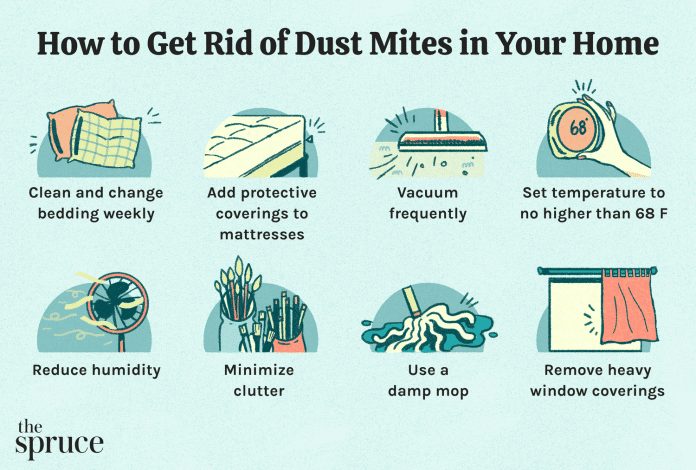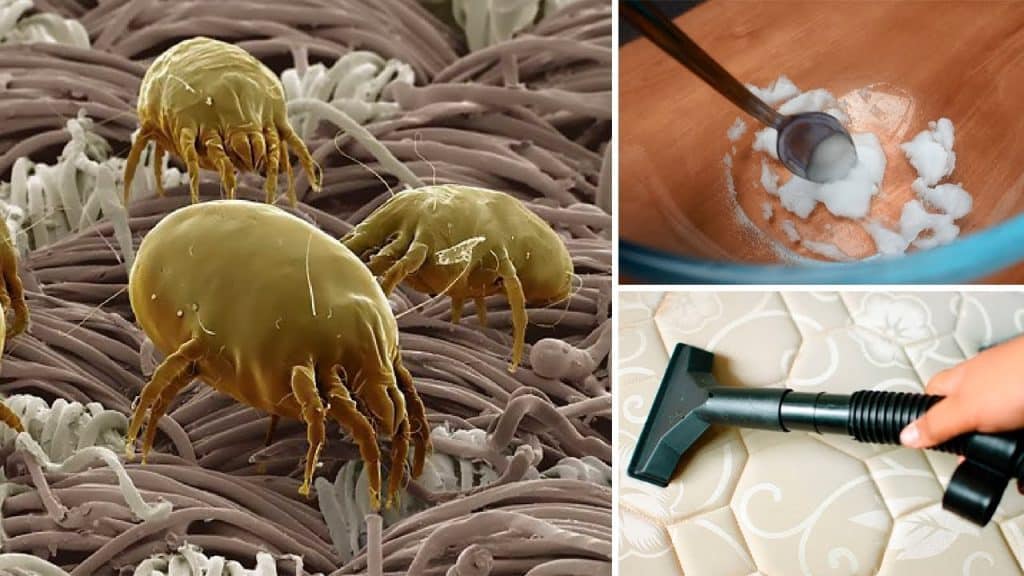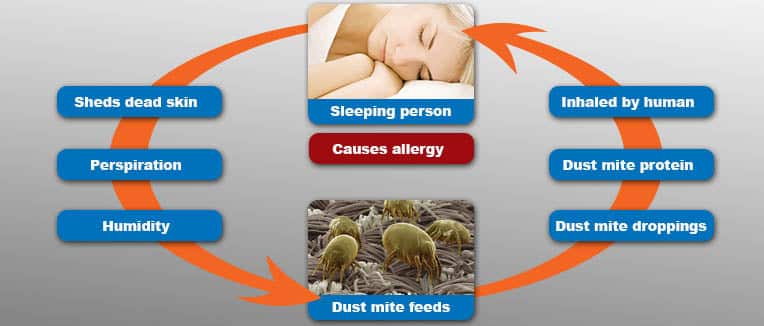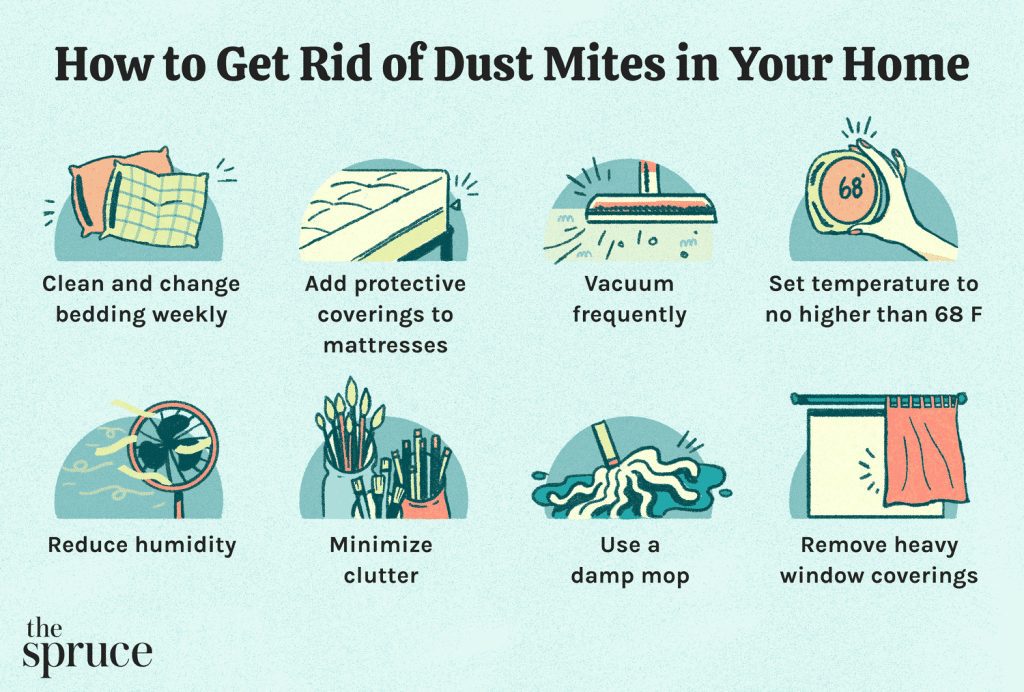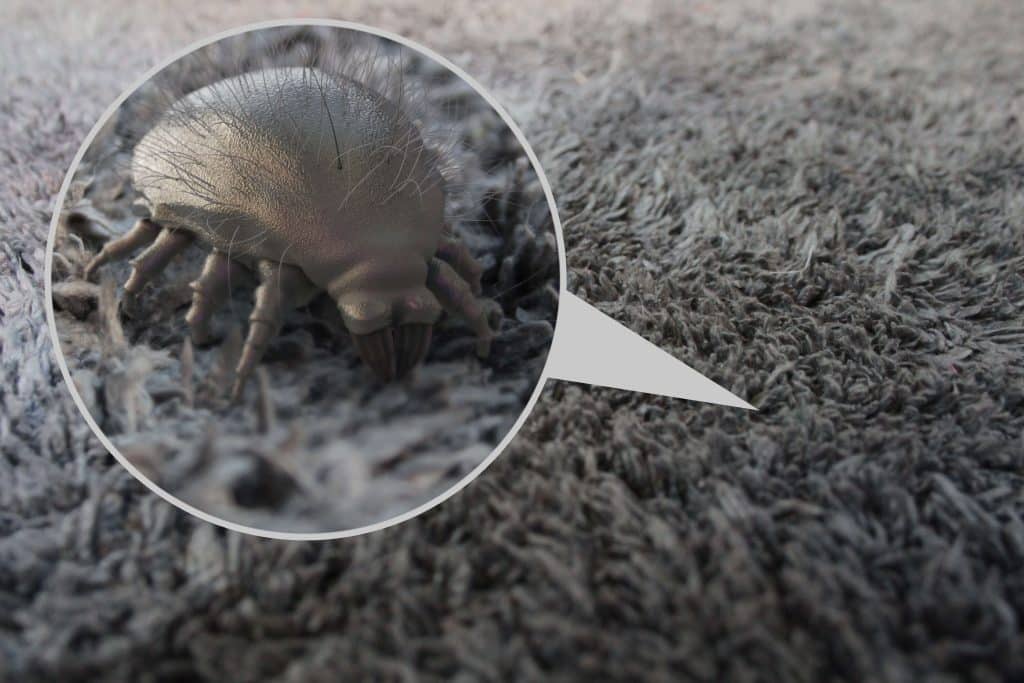Are you constantly waking up with a stuffy nose or itchy eyes? It could be the result of dust mites lurking in your mattress. Dust mites, microscopic creatures that feed on dead skin cells, are a common allergen that can cause discomfort and disrupt your sleep. But fret not, because we have a few simple yet effective methods to tackle this pesky problem and ensure you can rest easy once again.
Review contents
Cleaning Techniques
Keeping your mattress clean is essential for maintaining a healthy sleeping environment. Here are some effective cleaning techniques to get rid of dust mites in your mattress.
Vacuuming
Vacuuming your mattress regularly is a simple yet effective way to remove dust mites and their allergens. Use the upholstery attachment on your vacuum cleaner to gently vacuum the entire surface of the mattress. Pay extra attention to the seams and crevices where dust mites tend to accumulate. Vacuuming not only helps to eliminate dust mites but also removes dead skin flakes, another food source for these tiny pests.
Steam Cleaning
Steam cleaning is a powerful method to kill dust mites and sanitize your mattress. The high-temperature steam kills the mites by denaturing their proteins and breaking down their cell membranes. To steam clean your mattress, you can either use a handheld steam cleaner or hire a professional steam cleaning service. Make sure to allow your mattress to fully dry before placing any bedding on it.
Freezing
Believe it or not, freezing can also be an effective way to eliminate dust mites from your mattress. Seal your mattress in an airtight plastic cover and place it in a freezer for at least 24 hours. The extreme cold temperatures will kill the dust mites and their eggs. Once the freezing process is complete, allow the mattress to thaw and air out before using it again.
Sunlight Exposure
Dust mites thrive in humid environments, so exposing your mattress to direct sunlight can help reduce their population. Dust mites cannot survive in high temperatures, and the UV rays from the sun have a germicidal effect. Simply strip off all bedding and pillows from your mattress and place it in a sunny area for a few hours. The heat and light will help to kill the dust mites and freshen up your mattress.
Allergen-proof Mattress Covers
Investing in allergen-proof mattress covers is an excellent way to create a barrier between you and the dust mites. These covers are made of tightly woven fabrics that prevent dust mites and their allergens from passing through.
Importance of Mattress Covers
Using mattress covers is crucial because it forms a protective layer that prevents dust mites from infesting your mattress. These covers create a physical barrier that dust mites cannot penetrate, hence reducing their population and minimizing allergic reactions.
Choosing the Right Mattress Cover
When selecting a mattress cover, look for one that is labeled as allergen-proof or dust mite-proof. Opt for covers made of tightly woven fabrics like microfiber or polyester. Ensure the cover has a zipper closure that completely seals the mattress inside. Additionally, make sure the cover is breathable and doesn’t trap heat, ensuring a comfortable sleep experience.
Installing and Maintaining the Cover
To install the mattress cover, remove all bedding, and slip it over your mattress like a fitted sheet. Make sure to completely encase the mattress without any gaps or loose areas. Once installed, regularly check the cover for tears or damage and replace if necessary. It’s also important to wash the cover every few months following the manufacturer’s instructions to maintain its effectiveness.
This image is property of www.wikihow.com.
Washing and Drying Bedding
Properly washing and drying your bedding is a crucial step in reducing dust mite populations and minimizing allergic reactions.
Frequency of Washing
It is recommended to wash your bedding, including sheets, pillowcases, blankets, and duvet covers, at least once a week. This frequent washing helps to remove dust mite allergens, dead skin cells, and other debris that accumulate over time.
Hot Water and High Heat Drying
When washing bedding, use hot water, preferably at a temperature of 130°F (54.5°C) or higher. The high temperatures help to kill dust mites and remove allergens effectively. After washing, dry your bedding on high heat to further eliminate any remaining dust mites or allergens.
Choosing Hypoallergenic Detergents
Opt for hypoallergenic laundry detergents that are free from fragrances, dyes, and harsh chemicals. These gentle detergents are less likely to trigger allergies or irritate sensitive skin. Avoid using fabric softeners or dryer sheets as they may leave behind residue that can attract dust mites.
Dry Cleaning Option
If you have bedding items that are not machine washable, such as decorative pillows or certain duvets, consider using a dry cleaning service. Dry cleaning can effectively remove dust mites and their allergens from these items, ensuring a clean and allergy-free sleep environment.
Regular Mattress Maintenance
In addition to cleaning techniques, implementing regular maintenance practices can help keep your mattress free from dust mites and allergens.
Frequent Mattress Rotation
Rotate your mattress every few months to distribute the wear and tear evenly. This practice prevents the formation of body impressions and reduces the accumulation of dust mites. Simply flip the mattress from top to bottom and turn it around, ensuring all sides receive equal usage.
Beating and Banging Techniques
Periodically, take your mattress outdoors and beat it with a soft broom or a tennis racket. This action helps dislodge any trapped dust mites, dead skin cells, or other debris. Additionally, lightly bang your mattress with your fists to further agitate and remove any remaining dust mites.
Use of a HEPA-filtered Air Purifier
Investing in a high-quality air purifier with a HEPA (High-Efficiency Particulate Air) filter can significantly improve the air quality in your bedroom. HEPA filters effectively capture and trap tiny particles, including dust mite allergens, keeping the air clean and reducing the risk of allergic reactions. Place the air purifier near your bed for optimal results.
This image is property of cdn.shopify.com.
Natural Remedies
If you prefer to use natural methods to eliminate dust mites, here are some effective remedies you can try:
Baking Soda
Sprinkling baking soda on your mattress and leaving it for a few hours before vacuuming can help neutralize odors and absorb moisture, making it less hospitable for dust mites. Baking soda is a natural deodorizer and can also help freshen up your mattress.
Essential Oils
Certain essential oils, such as tea tree oil, eucalyptus oil, and lavender oil, have antimicrobial properties that can help repel dust mites. Mix a few drops of your chosen essential oil with water and spray it lightly on your mattress. Be cautious with essential oils if you or your sleeping partner have allergies or sensitivities.
Diatomaceous Earth
Diatomaceous earth is a fine powder made from fossilized diatoms, a type of algae. Sprinkling diatomaceous earth on your mattress can dehydrate and kill dust mites. Leave it for several hours and then vacuum it thoroughly to remove the powder and any dead dust mites.
Eucalyptus Leaves
Eucalyptus leaves contain natural compounds that are toxic to dust mites. Place a few dried eucalyptus leaves in a breathable fabric bag and tuck it under your mattress or between the mattress and box spring. The aroma from the leaves can help repel dust mites and add a pleasant scent to your sleeping environment.
Professional Cleaning Services
Sometimes, professional cleaning services can provide a thorough and effective solution for dust mite removal.
Benefits of Professional Cleaning
Professional cleaning services have specialized equipment and expertise to deep clean your mattress and remove dust mites effectively. They can use techniques such as steam cleaning, hot water extraction, or UV light treatment to ensure a thorough sanitization of your mattress.
Finding Reliable Service Providers
When seeking professional cleaning services, it’s important to do research and find reliable service providers. Look for companies with positive reviews and certifications in mattress cleaning. Ask for recommendations from friends or family members who have used such services before.
Regular Scheduled Cleanings
Consider scheduling regular professional cleanings to maintain a dust mite-free mattress. Many companies offer routine maintenance plans where they visit your home at regular intervals to clean and sanitize your mattress. This approach ensures a consistent and clean sleeping environment.
This image is property of cdn.shopify.com.
Avoidance Strategies
Implementing avoidance strategies can help prevent dust mites from infesting your mattress and reduce allergic reactions.
Reduce Humidity
Dust mites thrive in humid environments, so it’s essential to keep the humidity levels in your bedroom low. Use a dehumidifier to maintain optimal humidity levels between 30% and 50%. This will create an unfavorable environment for dust mites to survive and reproduce.
Frequent Dusting and Vacuuming
Regularly dust your bedroom surfaces and vacuum the floors to minimize the amount of dust and dust mite allergens in the environment. Use a damp cloth or a microfiber duster to trap and remove dust effectively.
Decluttering
Dust mites love cluttered areas as they provide ample hiding spots and collect more dust. Keep your bedroom tidy and free from unnecessary items that can attract dust mites. Minimize the number of decorative objects and store belongings in sealed containers to reduce dust buildup.
No Pets in the Bedroom
Pets can carry dust mites and other allergens into your bedroom. To prevent contamination, it’s advisable to keep pets out of the bedroom. Create designated sleeping areas for your pets in other parts of the house to minimize the risk of dust mites infiltrating your mattress.
Mattress Replacement
In some cases, it may be necessary to replace your mattress to effectively eliminate dust mites and improve your sleep environment.
When to Consider Replacement
If your mattress is old, heavily stained, or shows signs of wear and tear, it might be time for a replacement. Over time, mattresses become a breeding ground for dust mites, and even proper cleaning and maintenance may not be enough to eliminate them. Consider replacing your mattress every 7 to 10 years to ensure you have a clean and supportive sleep surface.
Choosing a Dust Mite-resistant Mattress
When shopping for a new mattress, look for options that are specifically designed to be resistant to dust mites. These mattresses often feature hypoallergenic materials or treatments that repel dust mites. Additionally, consider mattresses with removable and washable covers, as this allows for easier cleaning and maintenance.
Proper Disposal of Old Mattress
When disposing of an old mattress, it’s important to do so responsibly. Check with local waste management facilities or recycling centers to determine the best method for mattress disposal in your area. Avoid leaving your old mattress on the curb or dumping it illegally, as it can contribute to environmental pollution.
This image is property of www.thespruce.com.
Preventive Measures
Taking preventive measures can significantly reduce the risk of dust mite infestation and allergic reactions in your bedroom.
Air Filters and Purifiers
Using air filters and purifiers in your bedroom can help remove airborne dust mite allergens and improve the overall air quality. Look for models with HEPA filters, as they are highly efficient in capturing microscopic particles, including dust mites and their allergens.
Regularly Wash Stuffed Toys
If you have stuffed toys or pillows in your bedroom, make sure to wash them regularly. These items can harbor dust mites and their allergens, which can then transfer to your mattress and bedding. Follow the manufacturer’s instructions for washing and drying stuffed toys to ensure their cleanliness.
Avoid Plush Carpets
Plush carpets can be a breeding ground for dust mites. If possible, opt for hard flooring in your bedroom, such as hardwood or laminate, as it is easier to keep clean and dust mite-free. If you prefer carpets, choose low-pile options that can be vacuumed easily.
Regularly Wash Curtains
Curtains can accumulate dust and dust mite allergens over time. By washing your curtains regularly, you can minimize the presence of these allergens in your bedroom. Follow the care instructions on your curtains to ensure they are washed and dried properly.
Medical Treatments
If your dust mite allergies persist despite taking preventive measures and implementing cleaning techniques, it may be necessary to seek medical treatment.
Consulting a Doctor
If you experience persistent allergy symptoms, such as sneezing, congestion, or itchy eyes, consult a healthcare professional. They can perform tests to determine the specific allergens causing your symptoms and recommend appropriate treatments.
Prescription Medications
Your doctor may prescribe antihistamines, nasal corticosteroids, or other allergy medications to manage your dust mite allergies. These medications can help alleviate symptoms and improve your overall quality of life.
Immunotherapy Treatments
For severe dust mite allergies that do not respond to other treatments, allergen immunotherapy may be recommended. This treatment involves exposing you to small amounts of dust mite allergens over time, gradually desensitizing your immune system. Immunotherapy can provide long-term relief and reduce the severity of allergic reactions.
In conclusion, getting rid of dust mites in your mattress requires a combination of effective cleaning techniques, proper maintenance, and preventive measures. By regularly cleaning and maintaining your mattress, using allergen-proof covers, washing bedding, and implementing avoidance strategies, you can minimize the presence of dust mites and reduce allergic reactions. Consider natural remedies, professional cleaning services, and medical treatments if necessary. Remember, a clean and allergen-free mattress is vital for a restful and healthy sleep experience.
This image is property of www.bensonsforbeds.co.uk.

